SOME BIOLOGICAL INFORMATION OF THE PARROTFISH, SPARISOMA CRETENSE
(LINNAEUS, 1758) FROM THE EASTERN ADRIATIC
A. Pallaoro* and J. Dulcic
Institute of oceanography and Fisheries, Split, Croatia - * pallaoro@izor.hr
Abstract
This paper deals with the horizontal distribution and range spreading of the parrotfish in the Eastern Adriatic during the period 2000 –
2003. According to obtained data of 51 collected and measured specimens (27 females and 24 males) the length frequency distribution,
length - weight relationship, age and growth parameters are given.
Key words: Parrotfish, distribution, population parameters, Adriatic
Rapp. Comm. int. Mer Médit., 37,2004
418
Introduction
The parrotfish, Sparisoma cretense(Linnaeus, 1758) is subtropical,
reef-associated marine fish, found on photophile macroalgae covered
rocky substrates, sometimes in sea-grass (Posidonia oceanica) mead-
ows, at depths ranging from 20 to 50 m. It occurs in Eastern Atlantic
(from Portugal to the Canary Island and Senegal) and in the
Mediterranean (common in the Eastern, rather rare in Western Basin)
(1). The aim of this study is to present first data on some biological
parameters of parrotfish from the eastern Adriatic.
Material and methods
Total of 51 measured specimens, 24 males (47.1%) and 27 females
(52.9%) were caught on 8 stations in southern and middle Adriatic,
using the trammel bottom nets, fish trap and underwater speargun.
Results and discussion
The total body length (TL) (cm) of males ranged from 11.6 to
29.5 cm (
?
±SD = 22.2 ±4.98) and females from 10.2 to 27.4 cm
(
?
±SD = 20.2±4.99). Overall mean TL of males did not differ
significantly (t-test = 1.458; t
crit
= 2.021; p > 0.05) from that of
females.
The commonly used length - weight relationship was applied:
W = a Lt
b
. Weight of total collected fish ranged from 20.7 to 404.2 g.
Since the mean length did not differ significantly with sex, length -
weight relationship was calculated for sexes combined: a= 0.0243;
b= 2.871; r
2
= 0.9781 (Fig. 1). The slope (bvalue) was significantly
(= 7.21,
crit
. = 2.704) (P > 0.05) different from 3.0 indicating
negative allometry.
After reading scales for individuals the mean observed lengths at
age were estimated and used for fitting the von Bertalanffy growth
model. The growth parameters for sexes combined were: Lt = 35.14
(1 – e
– 0.298 (t + 0.597)
); r
2
= 0.9689. The theoretical maximum length,
35.1 cm of parrotfish in our investigation is not unrealistic since the
largest specimens can reach 50.0 cm Lt in Mediterranean (1) and
slightly less in the Adriatic (2). The oldest collected specimens were
6 years old.
Slightly different values of these biological parameters were
obtained for Greek waters (3).
As a result of scarce number of records up to 2000, parrotfish
belonged to the rare species in the Eastern Adriatic (4). Periodically it
was found mainly in the middle and southern part (one specimen -
Dubrovnik, 1900; Biševo Island, 1962; Šcedro Island, 1965; two
specimens - Hvar Island, 1904; Vis Island, 1925) but one unconfirmed
specimen was caught also in Venice, 1924 in north Adriatic (5).
Probably as a result of a warming up of the Mediterranean waters (6)
and changes in oceanographical conditions of the Adriatic Sea, popu-
lation density of Sparisoma cretensesuddenly increased in very warm
2000. From that year findings and captures of this thermophilous
species occurred more and more frequently, moving northwards to the
northern part of the middle Adriatic (Table. 1).
References
1-Randall J.E., 1990. Scaridae. Pp. 883-887.In:Quero J.C., Hureau J.C.,
Karrer C., Post A. and Saldanha L., (eds) Check-list of the fishes of the
eastern tropical Atlantic (CLOFETA). UNESCO, Paris, 2.
2-JardasI., 1996: Adriatic ichthyofauna. Školska knjigaPubl., Zagreb,
533 (in Croatian).
3-Petrakis G. and Papaconstantinou C., 1990. Biology of Sparisoma
cretensein the Dodecanese (Greece). J. Appl. Ichthyol., 6:14-23.
4-Pallaoro A. and Jardas I., 1996. Ichthyological collection of the
Institute of Oceanography and Fisheries in Split (Croatia). Nat. Croat., 3:
177–219.
5-Dulcic J. and Pallaoro A., 2001. Some new data on Xyrichthys
novacula(Linnaeus, 1758) and Sparisoma (Euscarus) cretense(Linnaeus,
1758) from the Eastern Adriatic. Annales, Ser. Hist. Nat., 11: 35-40.
6-Francour P., Boudouresque C.F., Harmelin J.G., Harmelin-Vivien M.L.
and Quignard J.P., 1994. Are the Mediterranean Waters becoming
Warmer? Information from Biological Indicators. Mar. Poll. Bull.,28 (9):
523–526.
Table 1. Sparisoma cretense. The successive northward spreading dur-
ing 2000-2003.
Fig. 1. Sparisoma cretense.Length - weight relationship, sexes
combined.

